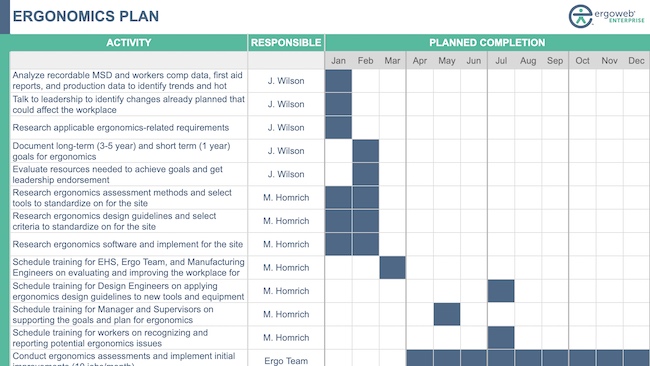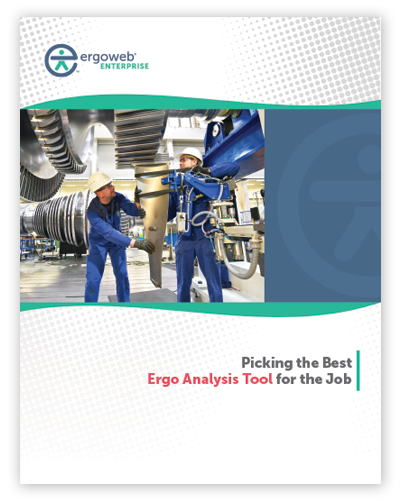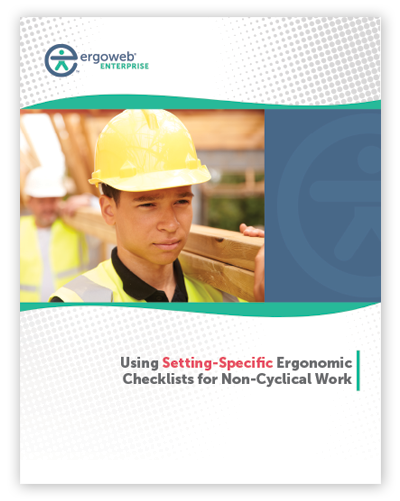Ergoweb® Learning Center
We’ve published and shared thousands of ergonomics articles and resources since 1993. Search by keyword or browse for topics of interest.
Downloadable Guides
Open Access Articles
October 18, 2012
Designers are often frustrated by humans. It sounds funny, because nearly all designs are destined to be used -- or misused -- by people, but it's true. Designing something to accommodate for the wide variety of human sizes and shapes can be so frustrating that many designers simply neglect to do it. Some neglect to accommodate intentionally, others try, yet make mistakes in the process, and still others neglect it out of pure ignorance.
October 17, 2012
A recent research article summarizing a study designed to update the anthropometry data for US based truck drivers reveals some interesting statistics about truck driver size and safety, and also brings to light the fact that ergonomists and designers often don't have accurate data, even if such data is critical to a design outcome. In this article Peter Budnick reviews the study and also shares some thoughts on the importance of human-centered design, up-to-date anthropometry data, as well as new developments in the way it is used to create more accommodating designs.
October 11, 2012
Presenting ergonomics solutions as valuable contributions to an organization is critical to getting them accepted, funded and implemented. This article, reprinted from The Ergonomics Report, recognizes that financial measures and predictions are a large motivating factor for any organizations, and ergonomics solutions must therefore be considered in light of their financial impacts. This article reviews the types of outcomes ergonomics can produce; shows how to do ROI calculations that put solutions in financial terms; and promotes an increased awareness of, and focus on, ergonomics performance outcomes, not just well-being outcomes.
October 9, 2012
In this reprint from The Ergonomics Report Archives, guest contributor Thomas J. Albin writes, "Checklists come in all forms and shapes: they may be self-developed, public or proprietary. We may call them surveys, risk identification forms, screening tools, assessment tools, or something else, but their purpose is to identify risk factors that put jobs 'at-risk'. Some checklists may have been validated for various contexts of use, others not at all ... we need to manage the use of checklists ... by collecting information on their reliability and validity just as one would gather information to manage any other manufacturing process. This can be done simply and dynamically by any practitioner in a way that is specific to the worksite for which they are responsible."
October 4, 2012
Spurred to write by our recent article, "A Strategy for Human Factors/Ergonomics as a Discipline and Profession (Reprint)," guest contributor Kieran Duignan offers his thought provoking ideas on why, "... regrettably the strategy paper by Jan Dul and others ... is unlikely to go near to where its authors aspire," because, "their aspirations for the HFE community ... fail to even mention the core challenge facing all forms of business and organisational consulting now, namely building trust with stakeholders." Duignan proposes a macroergonomics approach with a focus on the ergonomics community improving its collective "social intelligence."
October 3, 2012
In this reprint from The Ergonomics Report, a well formulated and executed ergonomics program is once again shown to be a significant contributor to the organizational bottom line. This recent evidence comes from research conducted by University of Wisconsin based researchers Garg and Kapellusch who tracked key business metrics at seven health care facilities with ergonomics programs that included patient handling equipment. While safe patient handling has become an important topic in many health care facilities, and regulators, the proven benefits of an ergonomics program are transferable to any workplace or industry.
September 26, 2012
A previous article, "Wellness: Why Ergonomists Need to Get Involved (Reprint)," by Jill Kelby, has drawn a spirited response from Laura Punnett, Robert Henning and Nicholas Warren, ergonomists from The Center for the Promotion of Health in the New England Workforce (CPH-NEW). They argue, contrary to Kelby's assertion that ergonomics is being "co-opted" by "others", that they have been involved in the NIOSH Total Worker Health (TWH) program, and that they have "made it our responsibility to educate others within TWH about the field of ergonomics," and encourage others to join them.
September 19, 2012
Ergoweb's Peter Budnick reviews and offers his opinions on a recent report by The Future of Ergonomics Committee, under the direction of the International Ergonomics Association (IEA). The report summarizes a strategic initiative for the world-wide promotion of the ergonomics discipline and profession in order to reach global excellence in HFE (human factors and ergonomics). The report does a nice job of summarizing the field of ergonomics, and specifies numerous specific values we can and should produce.
September 18, 2012
Ergoweb's Peter Budnick reviews a recently published study comparing 5 office chair designs. As he explains, "I found it challenging to sift through the results section and piece together a coherent description of their findings ... this article kept making me ask more questions than it was answering." He also uncovers a connection to same or similar research referenced as a 2008 study, describing benefits of a specific chair by a specific manufacturer, leaving him with additional questions and prompting him to reach out to the researchers and the manufacturer for additional background and interpretation. This article will be continued ...






